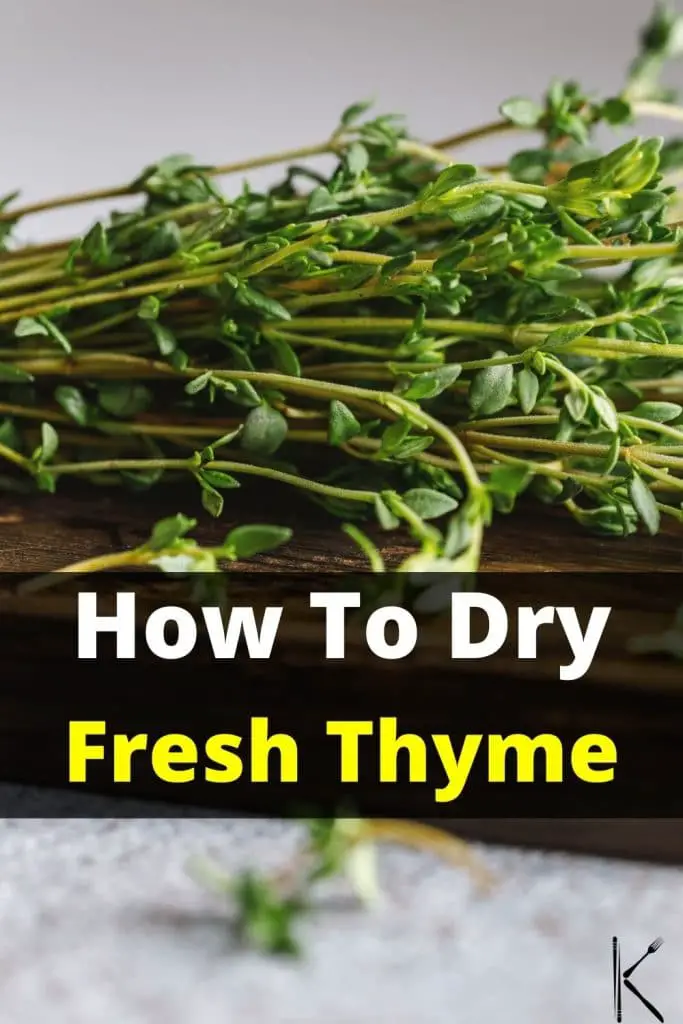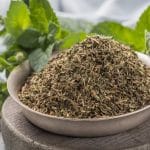Briefly, to dry fresh thyme, you can use four methods: Hanging, Air-drying on a tray, Oven-drying, or Microwave. Each method involves different steps and conditions, but the result is dried thyme that can be stored in a dry, cool, dark place for future use.
Fresh thyme is a flavorful savory herb that can be used whole or by picking the leaves from the stem.
The way you incorporate thyme in your dishes will depend on the cooking method. The great thing about this wonderful herb is that it dries well, and adds great flavor even after being dehydrated.
Here you will find out everything you need to know about drying thyme to ensure a year-round supply for your favorite recipes.
Can You Dry Thyme?
Yes, you can easily dry thyme. If you have plenty of your own thyme in your herb garden, drying is a great way to prolong its shelf life. There are several ways to dry the herb including air-drying by hanging, drying on a tray, or oven drying. The quickest method to dry thyme is in the microwave, however, slower methods using low heat will yield the best flavor preservation.
When you dry thyme leaves, it is important to ensure that they are completely dehydrated before packing as mold will develop if any moisture is present.
How to Harvest Thyme
To prepare homegrown herbs for drying, harvest the top 5 to 6 inches of the thyme stems. Leave the woody, tough parts. Clean thyme leaves do not need to be washed as this will also remove some of the flavorful essential oils.
If the thyme plant is dirty or dusty, lightly rinse the leaves or use a damp cloth to remove dirt. Place the leaves on a paper towel and pat dry to remove any remaining moisture. You can also use a salad spinner to help dry your fresh herbs.
Moisture on the leaves will increase the chance of moldy growth during the dehydration process.
If you dry thyme in the oven, the presence of water on the leaves will soften them instead of allowing them to crisp. It is, therefore, imperative that the leaves are completely dry of excess moisture before dehydrating thyme.
How To Dry Thyme
Here’s how to go from fresh thyme to dried:
Method 1: Dry by Hanging
Step 1: Tie Bundles
Tie a few thyme sprigs together with a piece of string, rubber band, or twist tie. Don’t make the bundles too big to ensure even drying.
Tip: Pierce a paper bag with holes and cover the herb bundles with the bag. This will protect them from dust but still allow sufficient airflow through. Do not use a plastic bag as this will not allow sufficient airflow which can cause mold.
Step 2: Hang
Hang the bundles of thyme to dry out of direct sunlight in a warm room with low humidity. Ensure the area is well ventilated to prevent the growth of mold.
The herbs will be dry within 1 to 2 weeks. The drying time will depend on the climate. Once completely dry, shriveled, and brittle, take them down.
Step 3: Pack
Working over a plate or a piece of wax paper, run your fingers down the stems to remove the leaves. They should come off easily. You can store the leaves whole or crumble them into small pieces.
Crushed leaves are easier to use in dressings and more palatable when incorporated into dishes.
Store the dried, crushed herbs in a glass jar or air tight container and label it with the date and contents.
Method 2: Air-Dry on a Tray
Spread the leaves out in a single layer on a parchment-lined baking sheet or rimmed dish. Place the tray in a warm room with low humidity. The leaves should not be in direct sunlight. Turn or shake the leaves every 12 hours to ensure even drying on all sides.
The leaves should dry out completely in a couple of days, becoming crisp and brittle. Use the same procedure to prepare the herbs for packing as in Method 1: Air-Dry by Hanging (Step 3).
Method 3: Oven-Dry
Step 1: Prepare Leaves
Spread out the cleaned thyme in a single layer on a baking sheet lined with parchment paper. The sprigs should not overlap each other.
Step 2: Bake
Set the oven to the lowest temperature setting at around 100 °F (40 °C). Thyme is best dried at a very low temperature for a long time. The leaves should stay in the oven for 24 hours. Check on them every few hours to ensure they are wilting, crisping, and do not burn.
When completely dry, the leaves should crumble easily when pinched between your fingers. Remove the baking tray from the oven.
Step 3: Pack
Run your fingers down the stem to remove leaves and crumble them into small pieces. Place your herbs in a resealable plastic bag, spice bottle, or mason jar. Label with the date and contents.
Always store thyme in a dry, cool, dark location, and out of direct sun.
Tip: If you use a food dehydrator instead of the oven, it will only take 2 hours to dry thyme at the same temperature.
Method 4: Microwave
To dry thyme in the microwave, lay the sprigs or leaves on paper towels in a single layer so that they do not overlap. Place another paper towel on top to cover the leaves. Microwave for 30 seconds on a high-power setting.
Thereafter, microwave in 15-second intervals until the leaves are fully dry and crunchy.
Remove the leaves from the sprigs and crumble them. Package the dried herbs in a labeled airtight container.
Types of Thyme
Thyme herb is part of the mint family. With over 50 varieties of the herb, there are ornamental fragrant types as well as culinary types of thyme. English thyme is popularly used in cooking while lemon thyme is also a well-liked variety with strong citrus notes.
Fresh thyme features thin woody stems with small leaves. The leaves can be used fresh or dried and impart more flavor the longer they cook.
Thyme is used in soups, stews, casseroles, pasta sauces, dressings, meat, and vegetable dishes. It can be incorporated into baked dishes such as quiche, bread, savory muffins, and turned into herb salt.
FAQs
Conclusion
Thyme can be dried in various ways without any special equipment. The method you choose will depend on the time and equipment you have available. If you live in a very humid climate, it is best to avoid air-drying and use an oven or dehydrator instead.
Regardless of which method you choose, ensure the herbs are completely dehydrated before packing to prevent mold. This way you will be able to enjoy your naturally dried herbs for over a year.
See more guides on how to dry cilantro, parsley, oregano, and basil.

*image by kshavratskaya/depositphotos









